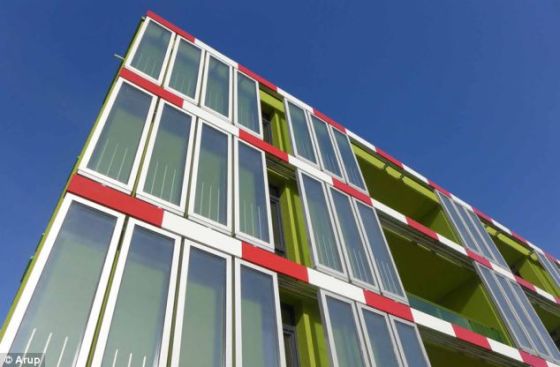 |
Structures designed by Arup, a Spanish engineering company, with front glass inlaid with bioreactors containing microalgae

Microalgae produce biomass and heat and is a renewable energy source
Beijing April 12 news, according to foreign media reports, Hamburg, Germany is building the world's first algae power generation buildings. The building was designed by Arup, a Spanish engineering company. The inset glass on the front was equipped with a bioreactor containing microalgae. These algae produce biomass and heat and are a renewable energy source. In addition, the system can also insulate and insulate the entire building and isolate noise.
At present, 129 bioreactors have been installed in the southwest and southeast of the building, measuring 2.5 meters by 0.7 meters. These reactors are controlled by an energy management center. The energy management center collects the sun's heat and stores it for hot water production. According to Garen-Ulm, head of Arup’s European R&D department, “Making use of the biochemical processes inside the front of the building to create shading and energy is a truly innovative idea. This is a sustainable solution. Can be used for energy production in the city. It is gratifying to be able to verify this idea in real life."
After Arup announced their vision for the future of skyscrapers, it was reported that Hamburg, Germany, had built the world’s first algae-powered buildings. According to their assumptions, the future skyscrapers will be “live buildings†powered by algae and able to automatically respond to changes in weather and residential needs. Arup is a multinational engineering company involved in construction projects including the Pompidou Center, the Sydney Opera House and many buildings of the 2008 Olympic Games.
What will happen to the city's architecture in 2050? Arup has made predictions. According to their predictions, jet power robot maintenance workers, skyscraper farms, and photovoltaic paints will all be used for future construction. All these are now in the R&D phase. According to a report released by Arup, “by 2050, urban residents and the city itself will always be in a state of flux, constantly changing and evolving to adapt to the emerging environment and conditions. The future of urban architecture will be 'natural' with this characteristic. Is like a living creature that responds to the local environment and interacts with residents."
According to research conducted by Arup's internal think tank, the future buildings will be fully integrated in the city's structure, able to respond to changes in the external environment, and have continuous adaptability in design. It is estimated that 40 years later, the global population will reach 9 billion, 75% of the population will live in cities, and the urban environment will change dramatically. Networked smart devices will rise in the future, allowing everything in the city to be manipulated in real time. Every component of an urban structure is a single intelligent system and part of an Internet of Things.
The most incredible prediction in Arup's report is that the future building will be the beneficiary of a brain-like intelligent construction system that can be automatically adjusted to meet the needs of residents. Use data on energy consumption, weather and residential needs. They can make reasonable decisions and optimize their use of resources. The future skyscraper will adopt a modular design and use jet-powered maintenance arm replacement modules. This modular assembly can be used for residential or commercial buildings, food production facilities, pastures, fisheries or vegetable plantations, depending on the actual needs.
The report pointed out: "In this emerging era, the research of architecture, prefabrication and modular systems will make great progress, and can be transported and assembled by robots. From the installation, testing, maintenance and upgrading of components, the entire building system can be seamless." Global population It will continue to grow rapidly, and Arup has also taken this factor into consideration when making predictions. The continued growth of the population will put enormous pressure on the already strained natural resources.
Arup pointed out in the report that because of the use of photovoltaic paint, wind turbines, and algae that can produce biofuels for the exterior walls, future buildings will generate more resources than they consume. The green space will be distributed throughout the entire building to enhance the diversity of the city. The water resources system will have both the functions of recycling, filtration and reduction of pollutants that affect the environment.
The facade of this building designed by Arup - which can use sunlight to generate electricity - can be coated with nanoparticles to neutralize pollutants in the air and capture carbon dioxide. Elements such as the giant organic LED allow all surfaces of the building to provide lighting at night, creating a new way of street lighting. The report said: "With the help of strong sunlight absorption capacity, this technology can make artificial lighting with a net energy consumption possible."
Arup's report, entitled "It is alive," was written by Joseph Hargrave, consultant to Arup's Vision + Innovation team. The Vision + Innovation team is Arup’s internal think tank, focusing on future buildings. He pointed out: "By producing food and energy, providing clean air and water, future buildings will transform from passive shells to creatures that are capable of adapting and responding to changes in the outside world - living buildings that can breathe will support The city's tomorrow." (Xiaowen)
Stainless Wire Basket,Stainless Steel Basket,Stainless Basket
Aluminum window Co., Ltd. , http://www.iron-fence-manufacturer.com